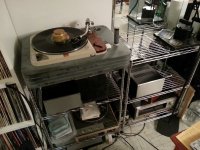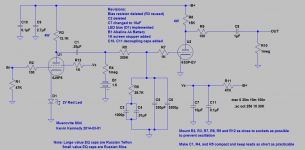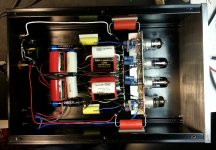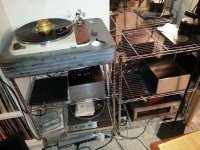I'm assuming it is something like the internal impedance is somewhat lower and high frequency behavior of these caps despite their monstrous size is more consistent than the 20yr old polycarbonate Spragues they replaced - which I would say did not sound shabby either. It's fairly subtle, but noticeable. I would have not been too surprised if they had not made any difference at all, at which point I would have pulled them out to use them somewhere where their much higher voltage rating is useful.
Power supply chassis arrived a few weeks ago, and am just waiting for the Edcor transformers and choke to arrive and I can finish it. It will be rather tight. I'll post some pix when I start the final build.
The 6F12P have arrived and I have a design. I will start a thread shortly on the Muscovite Micro - design looks promising, and is quite similar in design to this one sharing many of the same design features.
The 6F12P have arrived and I have a design. I will start a thread shortly on the Muscovite Micro - design looks promising, and is quite similar in design to this one sharing many of the same design features.
Hi kevin,
Sounds interesting. I gather you have made some tests on the 6F12P and found they are ok?
Mogens
Sounds interesting. I gather you have made some tests on the 6F12P and found they are ok?
Mogens
As you know, Kevin, I'm slowly pulling together the parts for the Mini and will build that soon. But I'll also follow the 6F12P design. I like your thorough and well-reasoned approach. I always seem to learn things from your designs - the Muscovite family particularly.
Carl
Carl
Hi Mogens,
I have not yet tested my samples of the 6F12P, but the ones I purchased appear to be well made which is usually ime a good indication of the overall tube quality. It will be a while before I prototype the micro as I ought to finish the mini psu first, and time, not to mention energy are limited.
I have not yet tested my samples of the 6F12P, but the ones I purchased appear to be well made which is usually ime a good indication of the overall tube quality. It will be a while before I prototype the micro as I ought to finish the mini psu first, and time, not to mention energy are limited.
Nice work Kevin.
Have you tried this preamp that has a corresponding EQ network with lower values of the serial resistor, say 15-20 Kohm?
Have you tried this preamp that has a corresponding EQ network with lower values of the serial resistor, say 15-20 Kohm?
I generally like at least 10x greater series resistance because the load impedance with passive EQ varies with frequency and results in response errors due to changing gain which is measurable with pentodes. I have used networks with series resistance as low as 27K with high transconductance triodes with an rp <3K..
Another concern relates to aging effects causing increasing rp in triodes, and decreasing rp in pentodes which will result in changes in frequency response over time.
Distortion is a concern as well.
Another concern relates to aging effects causing increasing rp in triodes, and decreasing rp in pentodes which will result in changes in frequency response over time.
Distortion is a concern as well.
Hi Kevin, as there are two varieties of 6J9's one short and another shorter, did you try both?
i have both types and have not used the shorter one, the short one sounds nice in a power amp in lieu of the ef86...
i have both types and have not used the shorter one, the short one sounds nice in a power amp in lieu of the ef86...
Another way is to employ μfollower topology and use the upper output which is a very low source impedance point. I have driven down to the 20s K Riaa like that from scrawny 12AX7 like tubes with good stability. But its not good to go very low for another reason even if the source impedance is low and stable. Slew rate. The lower impedance the passive filter is, the higher its capacitors values. Because climbing rate is how fast you charge a cap given the available current, its no good when the bias current ain't substantial in the driving stage. And in high gain low gm triodes, it ain't.I generally like at least 10x greater series resistance because the load impedance with passive EQ varies with frequency and results in response errors due to changing gain which is measurable with pentodes. I have used networks with series resistance as low as 27K with high transconductance triodes with an rp <3K..
Another concern relates to aging effects causing increasing rp in triodes, and decreasing rp in pentodes which will result in changes in frequency response over time.
Distortion is a concern as well.
Hi Kevin, as there are two varieties of 6J9's one short and another shorter, did you try both?
i have both types and have not used the shorter one, the short one sounds nice in a power amp in lieu of the ef86...
I'm using the super shortie version, i.e. the 6ж9п, I have not yet purchased any 6ж9п-e which from what I can tell is the longer version. The shortie sounds quite good.. (It's about the same size as a 5842.)
Still waiting for my power transformers and choke, they should be in next week and I can then complete the PSU. This should give me a better sense of what the ultimate limits of performance.
Another way is to employ μfollower topology and use the upper output which is a very low source impedance point. I have driven down to the 20s K Riaa like that from scrawny 12AX7 like tubes with good stability. But its not good to go very low for another reason even if the source impedance is low and stable. Slew rate. The lower impedance the passive filter is, the higher its capacitors values. Because climbing rate is how fast you charge a cap given the available current, its no good when the bias current ain't substantial in the driving stage. And in high gain low gm triodes, it ain't.
I decided that in this design simplicity would rule, the 6ж9п has quite high transconductance and is running at slightly over 10mA, the effective source impedance with RL and rp is approximately 9K.
The muscovite uses a relatively high current cascode in the front end and a choke augmented mu-follower in the second stage.
Slew rate is something I think about as well which is another reason why I avoid very low impedance EQ networks. The trade off of course is noise.
I'm using the super shortie version, i.e. the 6ж9п, I have not yet purchased any 6ж9п-e which from what I can tell is the longer version. The shortie sounds quite good.. (It's about the same size as a 5842.)
Still waiting for my power transformers and choke, they should be in next week and I can then complete the PSU. This should give me a better sense of what the ultimate limits of performance.
that's good news Kevin, if you liked the super shortie version, then i will use it in my amp, they are dirt cheap on the internet, and i have about 10 of those looking at both versions, only the glass envelope is different anyway...
speaking of the 5842, i have the Japanese version, 6R-R8.....
I don't have experience with the -e type but I would expect its performance to be quite comparable. It should offer enhanced reliability although I have not had any problems with the ones I am using.
Thanks Kevin.
I'm curious about your impressions with 6F12P.
Muscovite with ECF80 looks attractive. I like simple things.
I'm curious about your impressions with 6F12P.
Muscovite with ECF80 looks attractive. I like simple things.
I haven't gotten to really evaluating the 6F12P, decided a while go that I would focus on finishing one project at a time. Still waiting on the Edcore transformers for the mini..
I do have most of the parts for the micro (6F12P) design on hand and will start pretty soon to work on a prototype.
I do have most of the parts for the micro (6F12P) design on hand and will start pretty soon to work on a prototype.
Tonight I finished the PSU for the Muscovite Mini. I built a stereo version of the PSU using 6W6 as the pass tubes.
The whole thing is just packed. I managed to fit three power transformers, a choke, seven electrolytics, two large Clarity SA film caps, a Chinese made regulator for the filaments and the last two pcb I had left over from a long ago project for the HV power supplies which I have modified for the current supply version.
The whole thing is just packed. I managed to fit three power transformers, a choke, seven electrolytics, two large Clarity SA film caps, a Chinese made regulator for the filaments and the last two pcb I had left over from a long ago project for the HV power supplies which I have modified for the current supply version.
Attachments
Updated audio chassis schematic (retrofittable)
Some more minor updates for the individuals who are currently building this design.
To my considerable chagrin I have discovered that the Clarity SA cap on its own is not of sufficient quality to bypass the screen - it has audible colorations. I mitigated this significantly by installing a 0.1uF RTX in parallel with it. You could probably carry this a step further with an additional 1uF cap. Note that I have not measured or heard any evidence of capacitor resonances as a result of doing this. Since this proved to be audible I shunted the local 2.7uF supply decoupling cap with another 0.1uF.
I have attached an updated schematic here.
The only other difference of note is the use of 6W6 as pass tubes in the stereo PSU rather than 6V6 as discussed. Nearly twice the transconductance and plugs right in, caveat being much higher filament current.
I now have two fully independent TD-124 turntable set ups, the reference comprises the Muscovite, LL1941 suts, Schick arm, SPU Royal N.. The development table currently has a modified SME 3009 Series II, Meister Silver SPU, LL1941 SUTs, and Muscovite Mini..
The ultimate goal was to drive the Mini in the direction of comparable performance to the reference Muscovite. I believe I have succeeded. Anyone building this with sufficient care should be pleased with its performance IMHO.
Some more minor updates for the individuals who are currently building this design.
To my considerable chagrin I have discovered that the Clarity SA cap on its own is not of sufficient quality to bypass the screen - it has audible colorations. I mitigated this significantly by installing a 0.1uF RTX in parallel with it. You could probably carry this a step further with an additional 1uF cap. Note that I have not measured or heard any evidence of capacitor resonances as a result of doing this. Since this proved to be audible I shunted the local 2.7uF supply decoupling cap with another 0.1uF.
I have attached an updated schematic here.
The only other difference of note is the use of 6W6 as pass tubes in the stereo PSU rather than 6V6 as discussed. Nearly twice the transconductance and plugs right in, caveat being much higher filament current.
I now have two fully independent TD-124 turntable set ups, the reference comprises the Muscovite, LL1941 suts, Schick arm, SPU Royal N.. The development table currently has a modified SME 3009 Series II, Meister Silver SPU, LL1941 SUTs, and Muscovite Mini..
The ultimate goal was to drive the Mini in the direction of comparable performance to the reference Muscovite. I believe I have succeeded. Anyone building this with sufficient care should be pleased with its performance IMHO.
Attachments
Hi,
Great job, Kevin.😎
Either I've overlooked something or am already half asleep but wasn't the mini using a EL34 as a series pass tube in the original design of the reg?
Have a nice weekend, 😉
Great job, Kevin.😎
Either I've overlooked something or am already half asleep but wasn't the mini using a EL34 as a series pass tube in the original design of the reg?
The only other difference of note is the use of 6W6 as pass tubes in the stereo PSU rather than 6V6 as discussed. Nearly twice the transconductance and plugs right in, caveat being much higher filament current.
Have a nice weekend, 😉
Yes, that was one option for a shared PSU, I'd have used EL34s in the stereo version, but there was insufficient room due to height constraints.
As with everything I do it ended up being quite complicated even though it's not nearly as complex as the Muscovite which remains my reference. This was my first venture into a pentode based front end in a phono stage.
As with everything I do it ended up being quite complicated even though it's not nearly as complex as the Muscovite which remains my reference. This was my first venture into a pentode based front end in a phono stage.
- Status
- Not open for further replies.
- Home
- Source & Line
- Analogue Source
- The Muscovite Mini 6ж9п (6Z9P) Phono Stage




